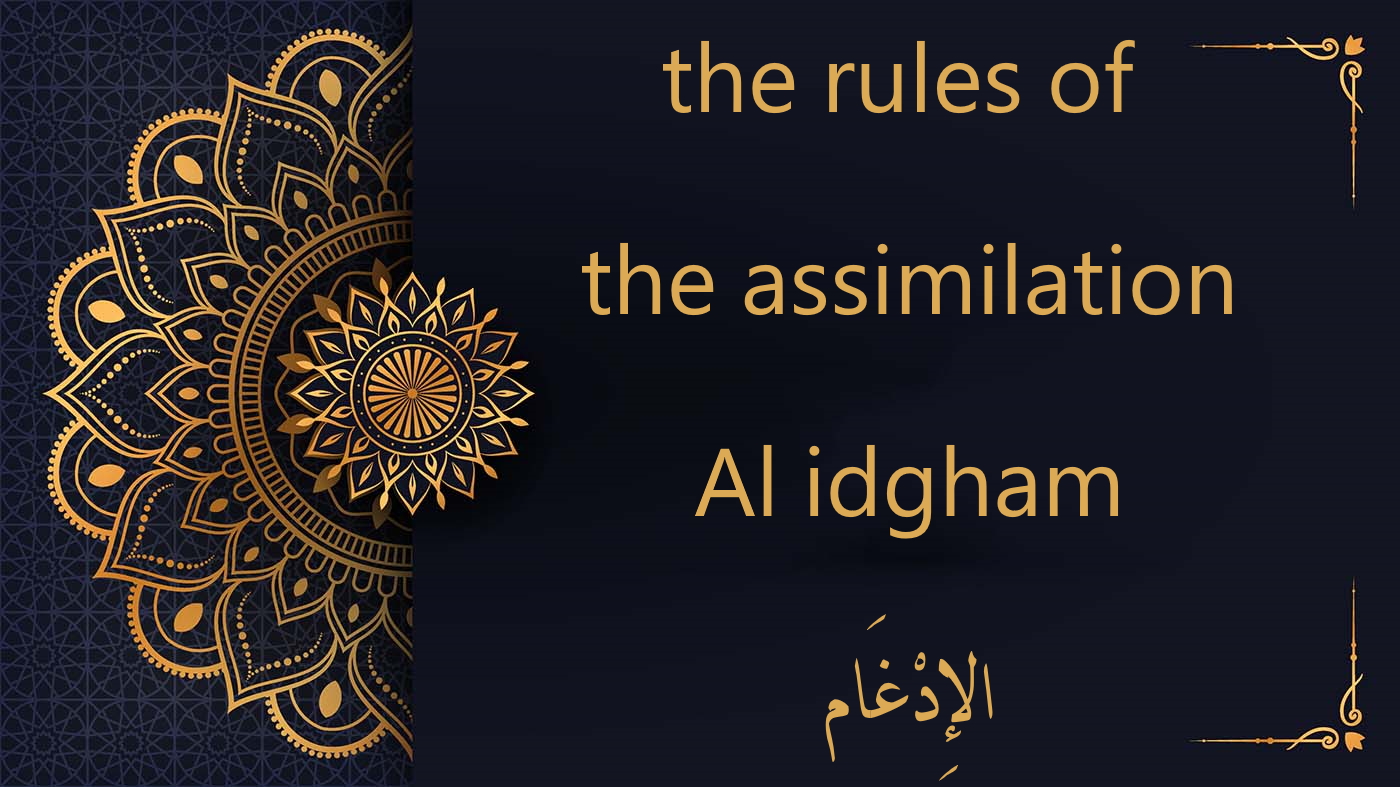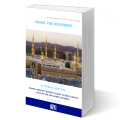
In the rich tapestry of the Arabic language, the term ‘assimilation’ or ‘idgham’ metaphorically captures the essence of one entity merging seamlessly into another.
Within the realm of Tajweed, this signifies the blend of the first letter into the subsequent one. It’s a harmonious convergence where one letter gracefully disappears, enriching the sound of the following.
Three primary forms of al-idgham manifest:
Moreover, when diving deeper into diverse recitation styles, idgham emerges in two significant variations:
The beauty of Tajweed lies in its precision and the harmonious dance of letters, and understanding idgham adds another layer to this intricate dance.
The Grand Assimilation, Al-Idgham Al-Kabeer, is applied to Al-Mutamathilayn, Al-Mutajanissayn, and Al-Mutaqaribayn when the initial letter is accentuated with a vowel mark.
Example:
وَإِذَا النُّفُوسُ زُوِّجَتْ
And when the souls are paired (81:7)
In the given illustration, the letter س seamlessly melds into the letter ز, effectively rendering it invisible.
This nuanced method of reading is distinctive to the styles of Abi Amroo and Ya’qub, albeit with slight variations between the two.
Contrastingly, in the recitation techniques of Asim and Nafi, this approach diverges. Their rule stipulates that for assimilation to occur, the initial letter must carry a sukoon, or be void of any vowel marks.
Widely accepted across all recitation styles, Al-Idgham As-Sagheer, or the subtle assimilation, is invoked when letters from the categories of mutamathilayn, mutajanissayn, and mutaqaribayn meet. Specifically, when the initial letter of the pair has a sukoon, it gracefully merges into, or becomes indistinguishable within, the succeeding vocalized (mutaharika) letter.
The nuances of this subtle idgham can be categorized as:
The realm of permissible idgham is particularly extensive and varies across different recitation styles, providing a rich tapestry of nuances and interpretations.
Let’s delve into a few illustrative examples:
كَلَّا ۖ بَل لَّا تُكْرِمُونَ الْيَتِيمَ
No! But you do not honour the orphan (89:17)
فَإِن كَذَّبُوكَ فَقُل رَّبُّكُمْ ذُو رَحْمَةٍ
So if they deny you, [O Muhammad], say, “Your Lord is the possessor of vast mercy (6:147)
As previously discussed, there are instances where idgham is strictly prohibited. Certain scenarios stand as exceptions to the general rules of idgham, disallowing any merger:
Letters of Madd (Prolongation): When the initial letter is one of the letters that cause elongation or prolongation in its pronunciation, assimilation is forbidden.
Let’s explore this through some examples:
تَعْرُجُ الْمَلَائِكَةُ وَالرُّوحُ إِلَيْهِ فِي يَوْمٍ كَانَ مِقْدَارُهُ خَمْسِينَ أَلْفَ سَنَةٍ
The angels and the Spirit will ascend to Him during a Day the extent of fifty thousand years. (70:4)
قَالُوا وَهُمْ فِيهَا يَخْتَصِمُونَ
They will say while they dispute therein, (26:96)
In this context, it’s crucial to uphold the madd (elongation) of the initial letter, ensuring its clear pronunciation. The idgham should not be applied in such instances. Instead, we adhere to the rule of ‘madd at-tamkeen’ for a steady and firm elongation.
Consensus among scholars dictates that assimilation – or idgham – of the letters lam and noon is prohibited, with the sole exception being the Lam in the definite article ال. Let’s delve into some illustrative examples:
قُلْ نَعَمْ وَأَنتُمْ دَاخِرُونَ
Say, “Yes, and you will be [rendered] contemptible.” (37:18)
قُلْ هَلْ نُنَبِّئُكُم بِالْأَخْسَرِينَ أَعْمَالً
Say, [O Muhammad], “Shall we [believers] inform you of the greatest losers as to [their] deeds? (18:103)
Example:
فَالْتَقَمَهُ الْحُوتُ وَهُوَ مُلِيمٌ
Then the fish swallowed him while he was blameworthy. (37:142)
Examples:
وَمِنَ اللَّيْلِ فَسَبِّحْهُ وَأَدْبَارَ السُّجُودِ
And [in part] of the night exalt Him and after prostration. (50:40)
وَمِنَ اللَّيْلِ فَسَبِّحْهُ وَإِدْبَارَ النُّجُومِ
And in a part of the night exalt Him and after [the setting of] the stars. (52:49)
رَبَّنَا لَا تُزِغْ قُلُوبَنَا بَعْدَ إِذْ هَدَيْتَنَا وَهَبْ لَنَا مِن لَّدُنكَ رَحْمَةً ۚ إِنَّكَ أَنتَ الْوَهَّابُ
[Who say], “Our Lord, let not our hearts deviate after You have guided us and grant us from Yourself mercy. Indeed, You are the Bestower. (3:8)
In the Hafs recitation, Al-Idgham As-Sagheer is mandated in the following scenarios:
In the process of assimilation, two letters are indistinguishable, sharing both the same endpoint and identical characteristics.
Example:
أَيْنَمَا تَكُونُوا يُدْرِككُّمُ الْمَوْتُ
Wherever you may be, death will overtake you (4:78)
From a technical standpoint, the letter involved in “al-idgham al-mutamathilayn” should be pronounced with the added emphasis associated with the shadda, and when it appears before the letters noon or meem, we should also execute a double-stroke ghunna.
Examples:
وَلَا أَنَا عَابِدٌ مَّا عَبَدتُّمْ
Nor will I be a worshipper of what you worship. (109:4)
فَآمَنَت طَّائِفَةٌ مِّن بَنِي إِسْرَائِيلَ وَكَفَرَت طَّائِفَةٌ
And a faction of the Children of Israel believed, and a faction disbelieved. (61:14)
In the Hafs Quranic recitation style, the rule of “al-idgham al-mutajanisayn” is applied in seven distinct instances:
Example:
وَعَادًا وَثَمُودَ وَقَد تَّبَيَّنَ لَكُم مِّن مَّسَاكِنِهِمْ
And [We destroyed] ‘Aad and Thamud, and it has become clear to you from their [ruined] dwellings (29:38)
Example:
فَلَمَّا أَثْقَلَت دَّعَوَا اللَّهَ رَبَّهُمَا لَئِنْ آتَيْتَنَا صَالِحًا لَّنَكُونَنَّ مِنَ الشَّاكِرِينَ
And when it becomes heavy, they both invoke Allah, their Lord, “If You should give us a good [child], we will surely be among the grateful.” (7:189)
Example:
إِذْ هَمَّت طَّائِفَتَانِ مِنكُمْ أَن تَفْشَلَا وَاللَّهُ وَلِيُّهُمَا
When two parties among you were about to lose courage, but Allah was their ally; (3:122)
Example:
فَمَكَثَ غَيْرَ بَعِيدٍ فَقَالَ أَحَطتُ بِمَا لَمْ تُحِطْ بِهِ وَجِئْتُكَ مِن سَبَإٍ بِنَبَإٍ يَقِينٍ
But the hoopoe stayed not long and said, “I have encompassed [in knowledge] that which you have not encompassed, and I have come to you from Sheba with certain news. (27:22)
In this particular scenario, we apply a milder form of assimilation known as “idgham naqees,” preserving the distinct quality of “al-isti’la” in the pronunciation of the letter “ت” while assimilating it with the letter “ط.
Example:
وَلَن يَنفَعَكُمُ الْيَوْمَ إِذ ظَّلَمْتُمْ أَنَّكُمْ فِي الْعَذَابِ مُشْتَرِكُونَ
And never will it benefit you that Day, when you have wronged, that you are [all] sharing in the punishment. (43:39)
Example:
فَمَثَلُهُ كَمَثَلِ الْكَلْبِ إِن تَحْمِلْ عَلَيْهِ يَلْهَثْ أَوْ تَتْرُكْهُ يَلْهَث ۚ ذَّٰلِكَ مَثَلُ الْقَوْمِ الَّذِينَ كَذَّبُوا بِآيَاتِنَا
So his example is like that of the dog: if you chase him, he pants, or if you leave him, he [still] pants. That is the example of the people who denied Our signs (7:176)
Example:
وَكَانَ فِي مَعْزِلٍ يَا بُنَيَّ ارْكَب مَّعَنَا وَلَا تَكُن مَّعَ الْكَافِرِينَ
“O my son, come aboard with us and be not with the disbelievers.” (11:42)
Hence, from a technical perspective, we do not enunciate the initial letter in “al-idgham al-mutajanisayn,” whereas the second letter is articulated with the added emphasis attributed to the shadda.
This phenomenon is referred to as such when the two subsequent letters share proximate articulation points yet possess distinct characteristics.
Mandatory mergers occur exclusively in two instances:
Examples:
وَقُل رَّبِّ زِدْنِي عِلْمًا
“My Lord, increase me in knowledge.” (20:114)
أَلَمْ نَخْلُقكُّم مِّن مَّاءٍ مَّهِينٍ
Did We not create you from a liquid disdained? (77:20)
When it comes to the merger of the letter ق with the letter ك, there exists a divergence in the choice of idgham to be applied.
Certain scholars advocate for an idgham “naqis,” which involves a slight merging by pronouncing the ك while retaining the distinct characteristic of “isti’ala” from the ق.
On the other hand, some scholars advocate for a pure idgham.
Technically, in the case of “al-idgham al-mutaqaribayn,” the first letter is not articulated separately, but the second letter is pronounced with added emphasis due to the shadda.
This Tajweed rules lesson has concluded. Insha’Allah, the next lesson will cover the rules of the beginning and the rules for stopping during the recitation.
At the Al-dirassa Institute, we provide an accessible path to mastering Tajweed under the guidance of skilled instructors. Should you wish to pursue this further, we warmly invite you to reach out to us.
Discover the experiences of our delighted clients who have thoroughly enjoyed utilizing this standout feature.
Alhamdulillah I‘m very pleased with the arabic and Qur’an lessons I receive from teacher Umm Tasneem and I‘m also content with the al-dirassa administration team who were very quick in answering any questions I had. In a month I progressed a lot and I cannot wait to continue my studies with al-dirassa. May Allah reward everyone at al-dirassa.
Verified review - view original
My Qur’an teacher is fantastic, she teaches me in a loving and kind way where I look forward to the lessons and learn so much. My Arabic teacher is equally as nice and has a lot of patience with me, she has great expertise in the field and I’ve progressed really quickly with her. Thank you Al-dirassa!
Verified review - view original
Don’t want to go through the translation anymore?
30 free minutes with your qualified Egyptian teacher.

Al-dirassa Institute offers you a gift to help you begin your journey to being fluent in Arabic and learning the Quran.

Al-dirassa Institute offers you a gift to help you begin your journey to being fluent in Arabic and learning the Quran.